GMC SIERRA 1994 Owners Manual
Manufacturer: GMC, Model Year: 1994, Model line: SIERRA, Model: GMC SIERRA 1994Pages: 404, PDF Size: 20.91 MB
Page 261 of 404
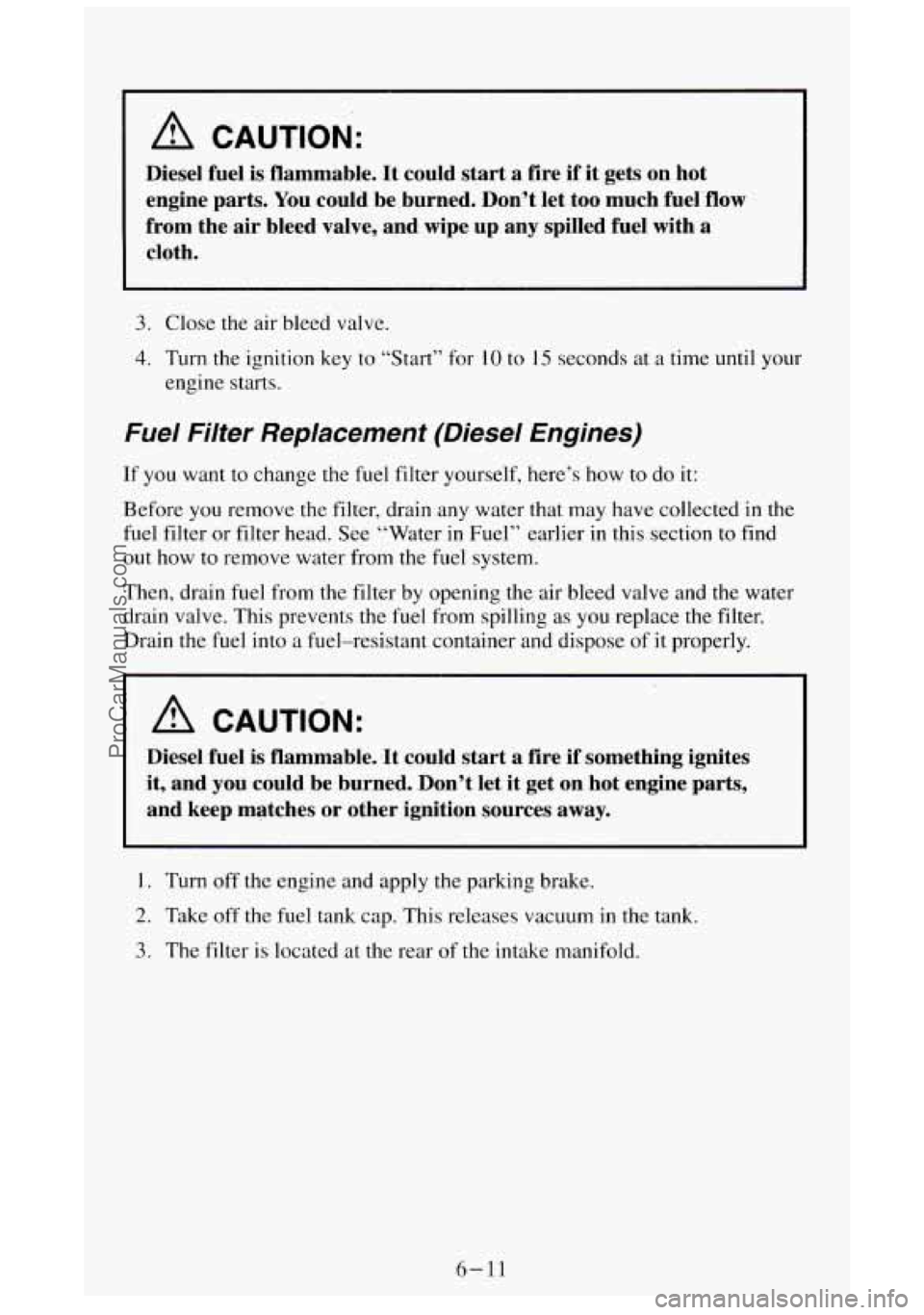
A CAUTION:
Diesel fuel is flammable. It could start a fire if it gets on hot
engine parts. You could be burned. Don’t let too much fuel flow
from the air bleed valve, and wipe up any spilled fuel with
a
cloth.
3. Close the air bleed valve.
4. Turn the ignition key to “Start” for 10 to 15 seconds at a time until your
engine starts.
Fuel Filter Replacement (Diesel Engines)
If you want to change the fuel filter yourself, here’s how to do it:
Before you remove the filter, drain any water that may have collected in the
fuel filter or filter head. See “Water in Fuel” earlier in this section to find
out how to remove water from the fuel system.
Then, drain
fuel from the filter by opening the air bleed valve and the water
drain valve. This prevents the fuel from spilling as
you replace the filter.
Drain the fuel into
a fuel-resistant container and dispose of it properly.
A CAUTION:
Diesel fuel is flammable. It could start a fire if something ignites
it, and you could be burned. Don’t let it get on hot engine parts,
and keep matches or other ignition sources away.
I. Turn off the engine and apply the parking brake.
2. Take off the fuel tank cap. This releases vacuum in the tank.
3. The filter is located at the rear of the intake manifold.
6-11
ProCarManuals.com
Page 262 of 404
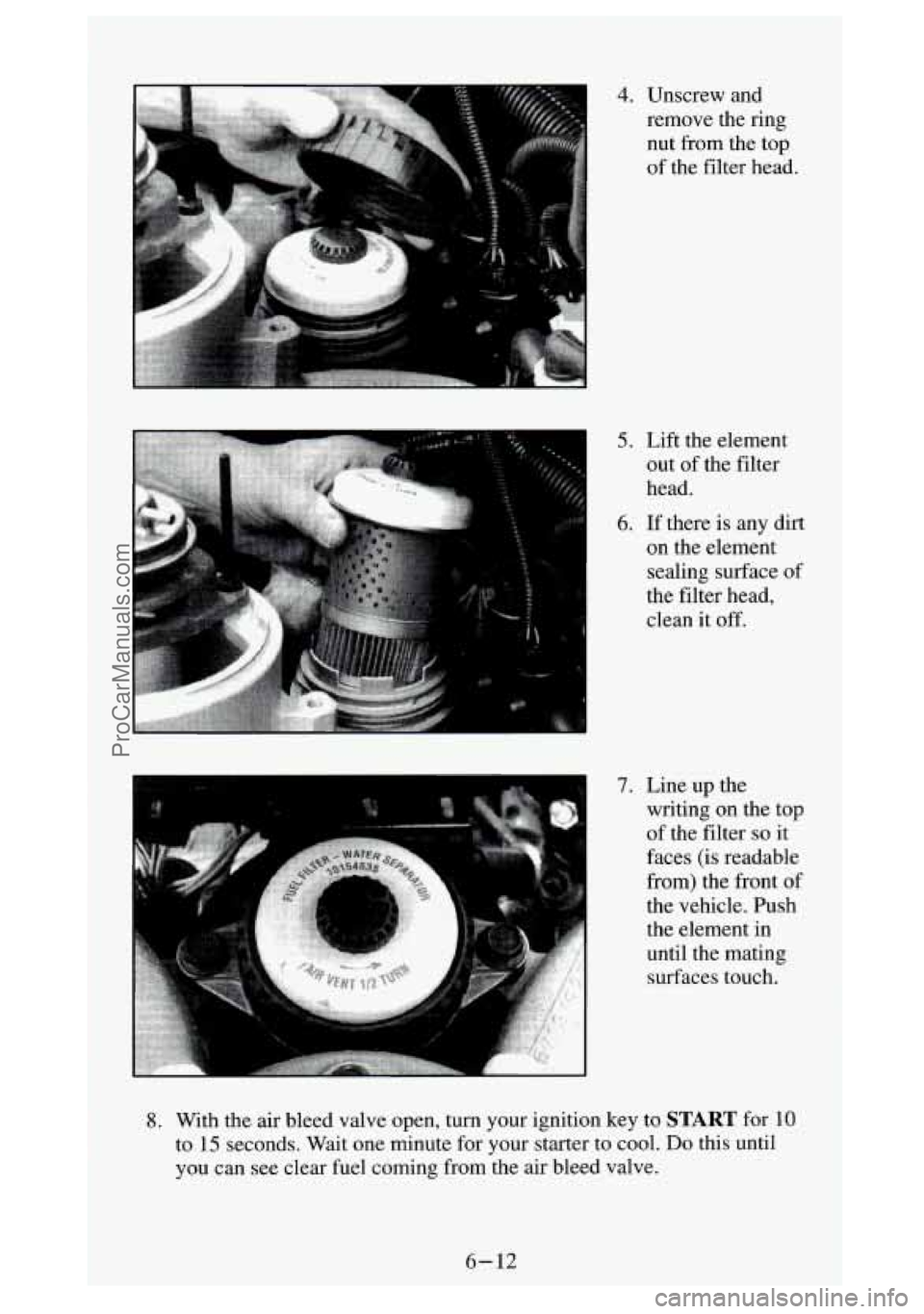
4. Unscrew and
remove the ring
nut from the top
of the filter head.
7. Line up the
writing on the top
of the filter
so it
faces (is readable
from) the front of
the vehicle. Push
the element in
until the mating
surfaces touch.
5. Lift the element
out of the filter
head.
6. If there is any dirt
on the element
sealing surface of
the filter head,
clean it
off.
8. With the air bleed valve open, turn your ignition key to START for 10
to 15 seconds. Wait one minute for your starter to cool. Do this until
you can see clear fuel coming from the air bleed valve.
ProCarManuals.com
Page 263 of 404
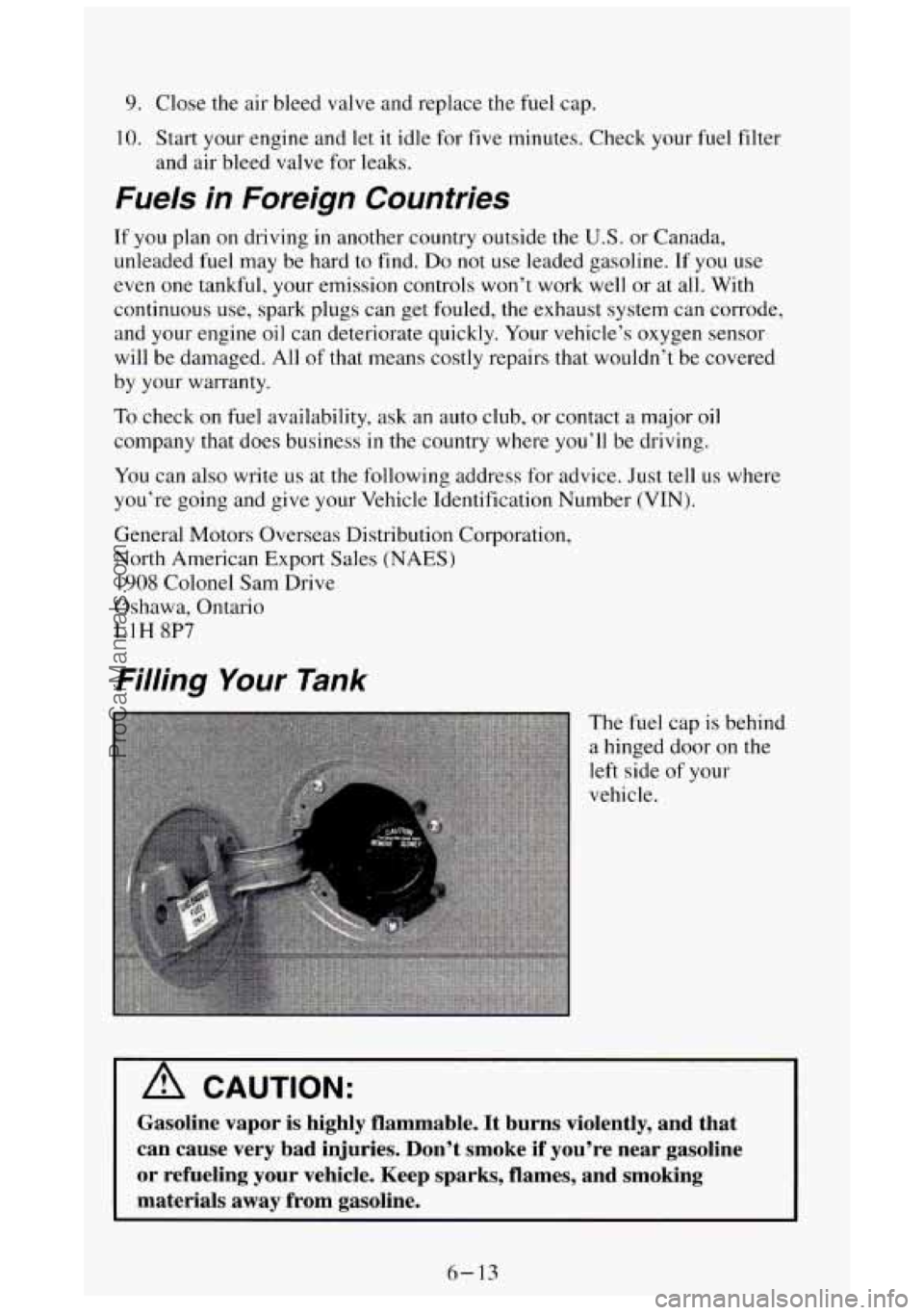
9. Close the air bleed valve and replace the fuel cap.
10. Start your engine and let it idle for five minutes. Check your fuel filter
and air bleed valve for leaks.
Fuels in Foreign Countries
If you plan on driving in another country outside the U.S. or Canada,
unleaded fuel may be hard to find. Do not use leaded gasoline.
If you use
even one tankful, your emission controls won’t work well or at all. With
continuous use, spark plugs can get fouled, the exhaust system can corrode,
and your engine oil can deteriorate quickly. Your vehicle’s oxygen sensor
will be damaged. All of that means costly repairs that wouldn’t be covered
by your warranty.
To check on fuel availability, ask an auto club, or contact a major oil
company that does business
in the country where you’ll be driving.
You can also write us at the following address for advice. Just tell us where
you’re going and give your Vehicle Identification Number (VIN).
General Motors Overseas Distribution Corporation,
North American Export Sales (NAES)
1908 Colonel
Sam Drive
Oshawa, Ontario
L1H 8P7
Filling Your Tank
The fuel cap is behind
a hinged door on the
left side of your
vehicle.
/i CAUTION:
Gasoline vapor is highly flammable. It burns vioIently, and tha\
t
can cause very
bad injuries. Don’t smoke if you’re near gasoline
or refueling your vehicle. Keep sparks, flames, and smoking
materials away from gasoline.
6-13
ProCarManuals.com
Page 264 of 404
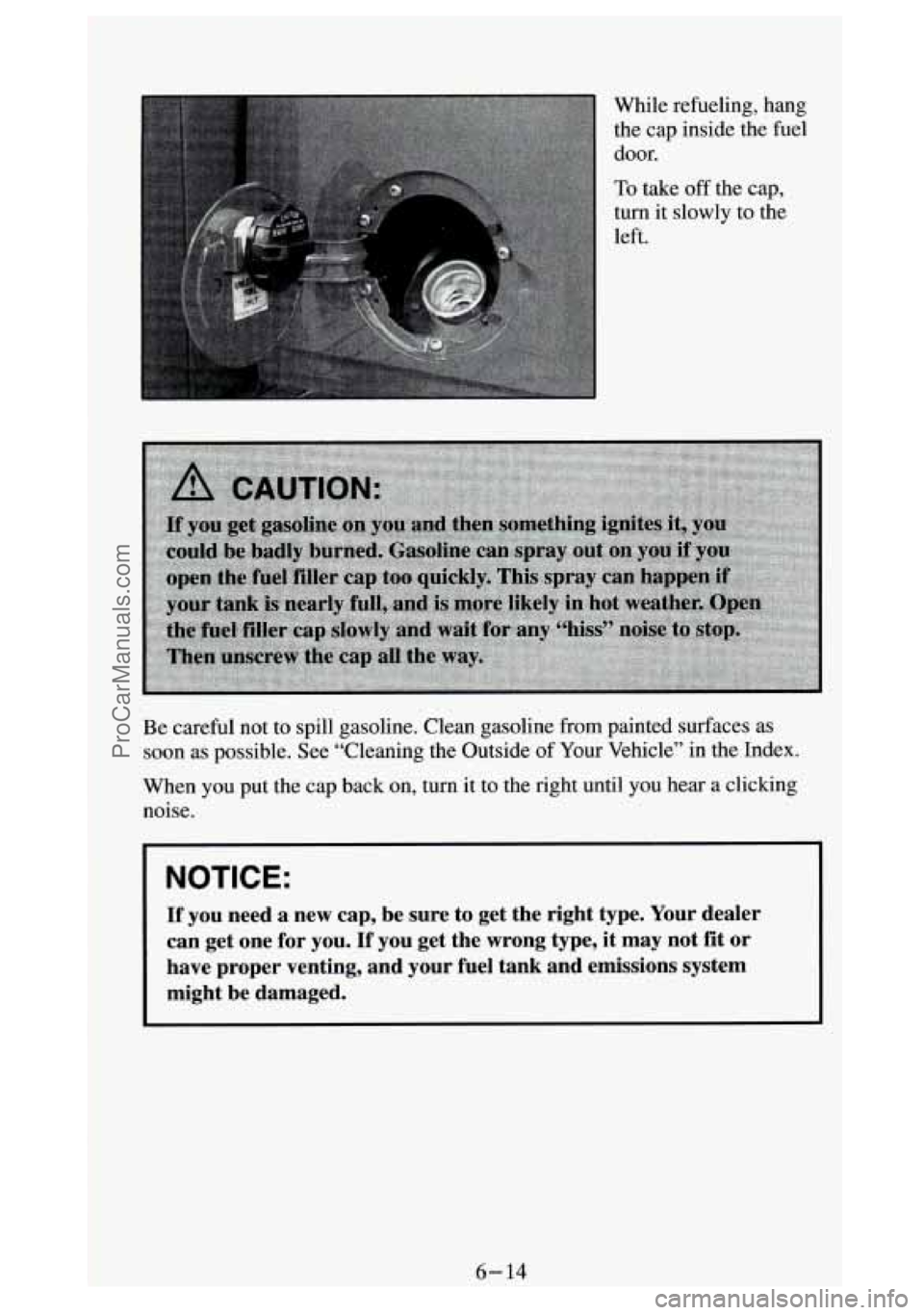
While refueling, hang the cap inside the fuel
door.
To take off the cap,
turn it slowly to the
left.
Be careful not to spill gasoline. Clean gasoline from painted \
surfaces as soon as possible. See “Cleaning
the Outside of Your Vehicle” in the Index.
When you put the cap back on, turn it to the right until
you hear a clicking
noise.
I NOTICE:
If you need a new cap, be sure to get the right type. Your \
dealer
can get one for you. If
you get the wrong type, it may not €it or
have proper venting, and your fuel tank and emissions system
might be damaged.
6-14
ProCarManuals.com
Page 265 of 404
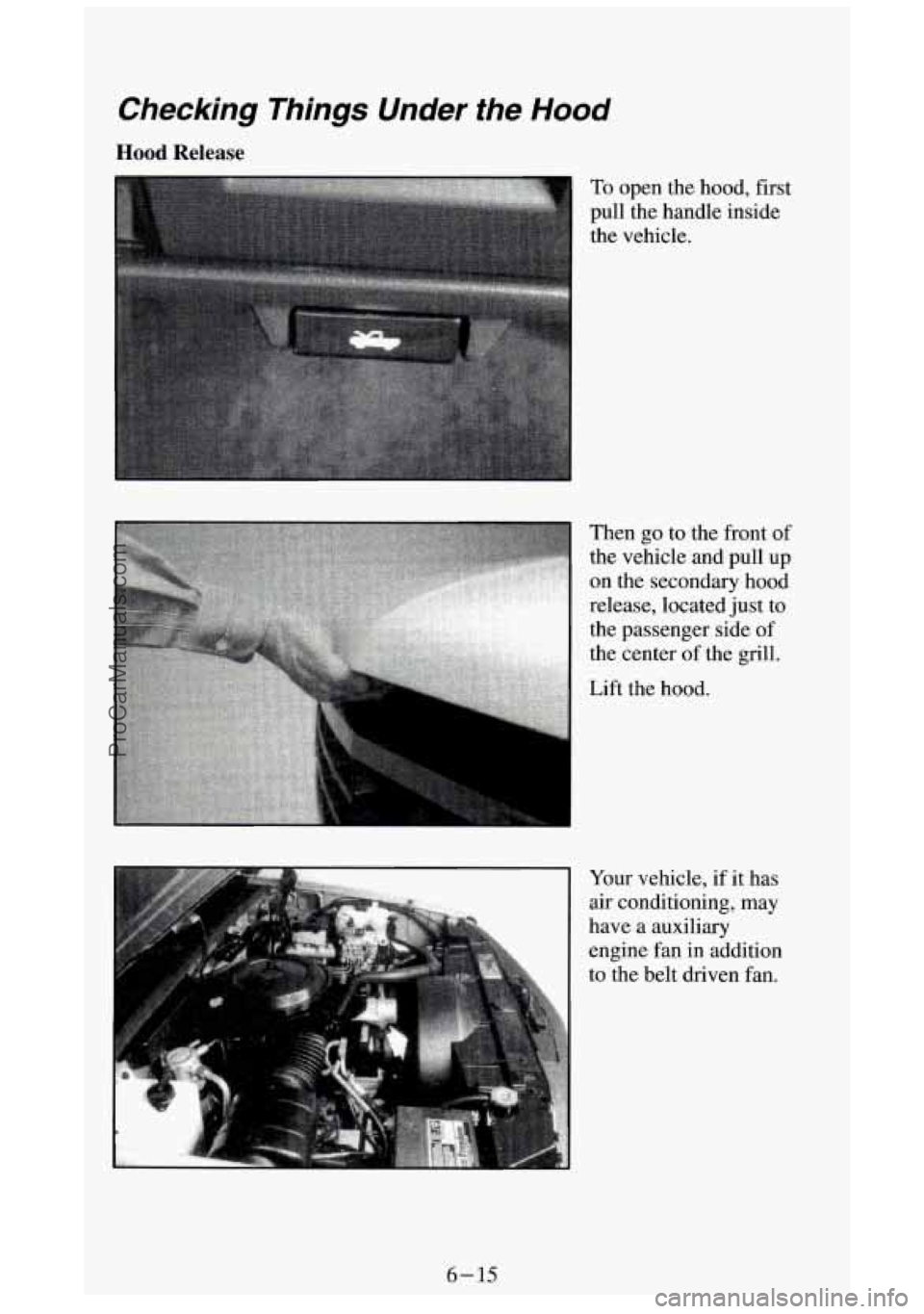
Checking Things Under the Hood
Iood Release
To open the hood, first
pull the handle inside
the vehicle.
Then go to the front
of
the vehicle and pull up
on the secondary hood
release, located just to
the passenger side of
the center of the grill.
Lift the hood.
Your vehicle,
if it has
air conditioning, may
have a auxiliary engine fan in addition
to the belt driven fan.
6- 15
ProCarManuals.com
Page 266 of 404
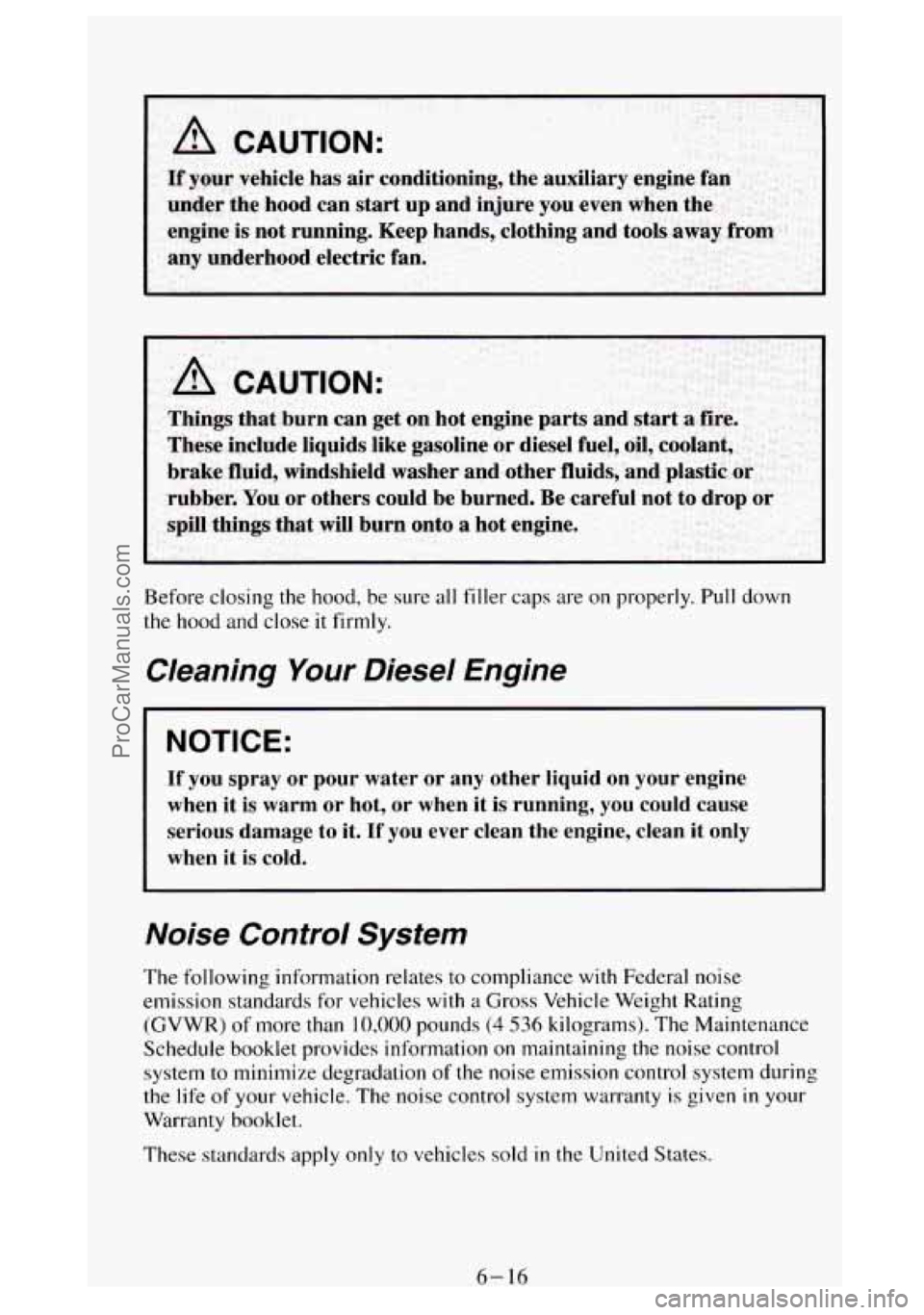
Things that burn can get on hot engine parts and start a fire.
These include liquids like gasoline or diesel fuel, oil, coolant,
brake fluid, windshield washer and other fluids, and plastic or
rubber. You or others could be burned. Be careful not to drop or
I spill things that will burn onto a hot engine.
Before closing the hood, be sure all filler caps are on properly. Pull down
the hood and close it firmly.
Cleaning Your Diesel Engine
NOTICE:
If you spray or pour water or any other liquid on your engine
when it is warm or hot, or when it is running,
you could cause
serious damage to it.
If you ever clean the engine, clean it only
when it is cold.
Noise Control System
The following information relates to compliance with Federal noise
emission standards for vehicles
with a Gross Vehicle Weight Rating
(GVWR) of more than
10,000 pounds (4 536 kilograms). The Maintenance
Schedule booklet provides information on maintaining the noise control
system to minimize degradation
of the noise emission control system during
the life of your vehicle. The noise control system warranty
is given in your
Warranty hooklet.
These standards apply only to vehicles sold
in the United States.
6- 16
ProCarManuals.com
Page 267 of 404
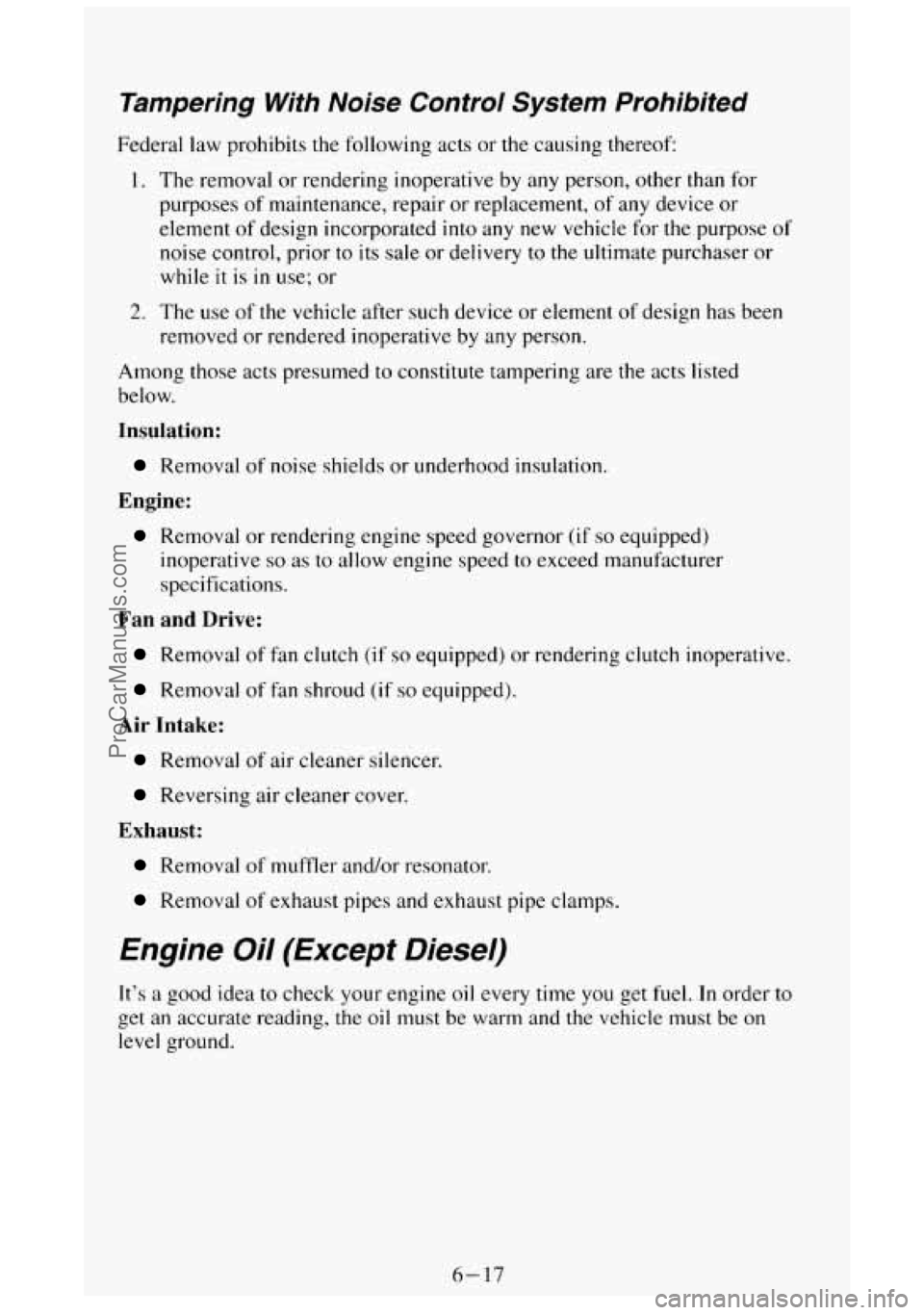
Tampering With Noise Control System Prohibited
Federal law prohibits the following acts or the causing thereof:
1 . The removal or rendering inoperative by any person, other than for
purposes
of maintenance, repair or replacement, of any device or
element
of design incorporated into any new vehicle for the purpose of
noise control, prior to its sale or delivery to the ultimate purchaser or
while
it is in use; or
2. The use of the vehicle after such device or element of design has been
removed or rendered inoperative by any person.
Among those acts presumed to constitute tampering are the acts listed
below.
Insulation:
Removal of noise shields or underhood insulation.
Engine:
Removal or rendering engine speed governor (if so equipped)
inoperative
so as to allow engine speed to exceed manufacturer
specifications.
Fan and Drive:
Removal of fan clutch (if so equipped) or rendering clutch inoperative.
Removal of fan shroud (if so equipped).
Air Intake:
Removal of air cleaner silencer.
Reversing air cleaner cover.
Exhaust:
Removal of muffler and/or resonator.
Removal of exhaust pipes and exhaust pipe clamps.
Engine Oil (Except Diesel)
It’s a good idea to check your engine oil every time you get fuel. In order to
get an accurate reading, the oil must be warm and the vehicle must be on
level ground.
ProCarManuals.com
Page 268 of 404
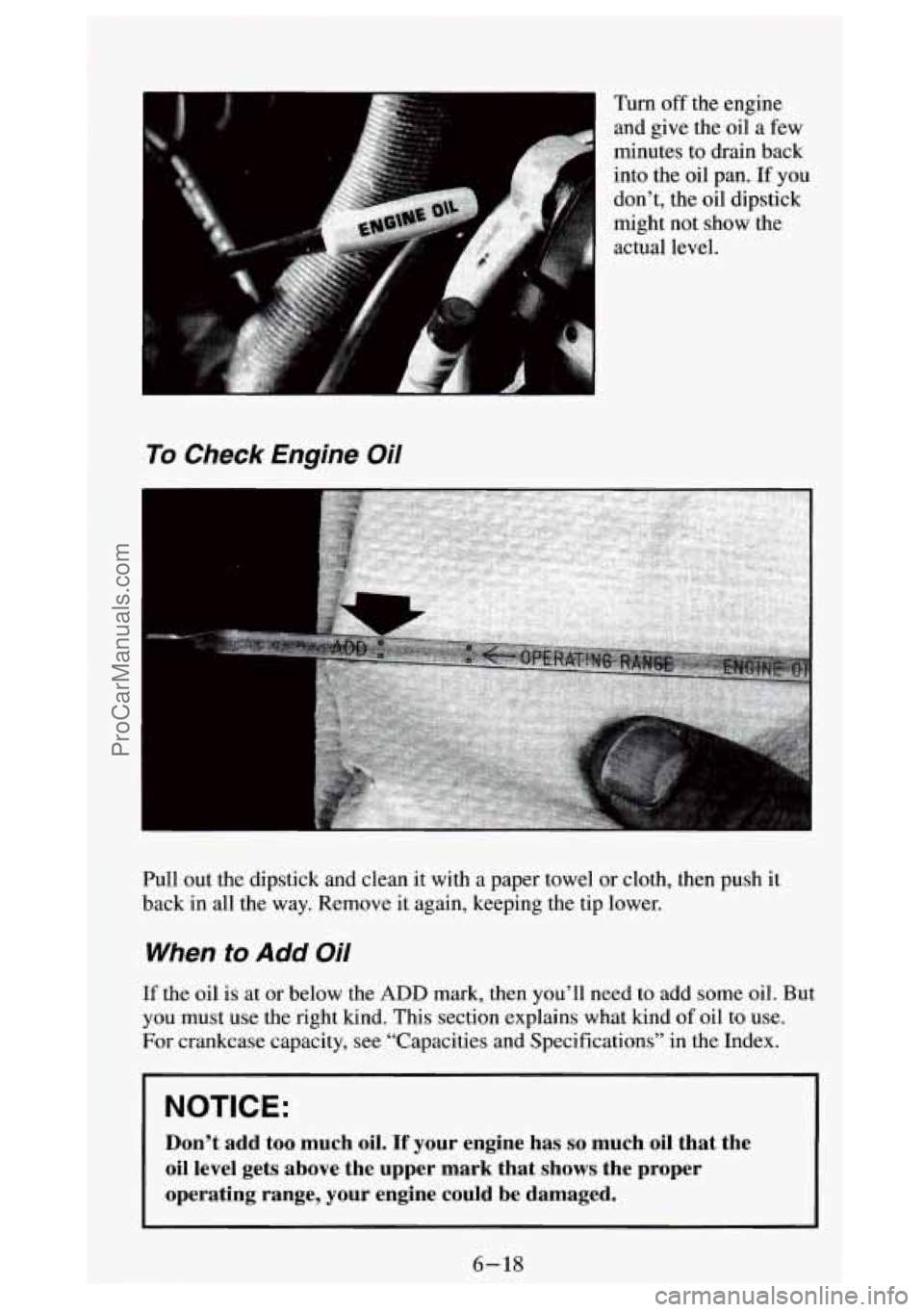
I
I
I
To Check Engine Oil
Turn off the engine
and give the oil a few
minutes to drain back
into the
oil pan. If you
don’t, the oil dipstick
might
not show the
actual level.
Pull out the dipstick and clean it with
a paper towel or cloth, then push it
back in all the way. Remove it again, keeping the tip lower.
When to Add Oil
If the oil is at or below the ADD mark, then you’ll need to add some oil. But
you must use the right kind. This section explains what kind of oil
to use.
For crankcase capacity, see “Capacities and Specifications”
in the Index.
NOTICE:
Don’t add too much oil. If your engine has so much oil that the
oil level gets above the upper mark that shows the proper
operating range, your engine could be damaged.
6-18
t I- ProCarManuals.com
Page 269 of 404
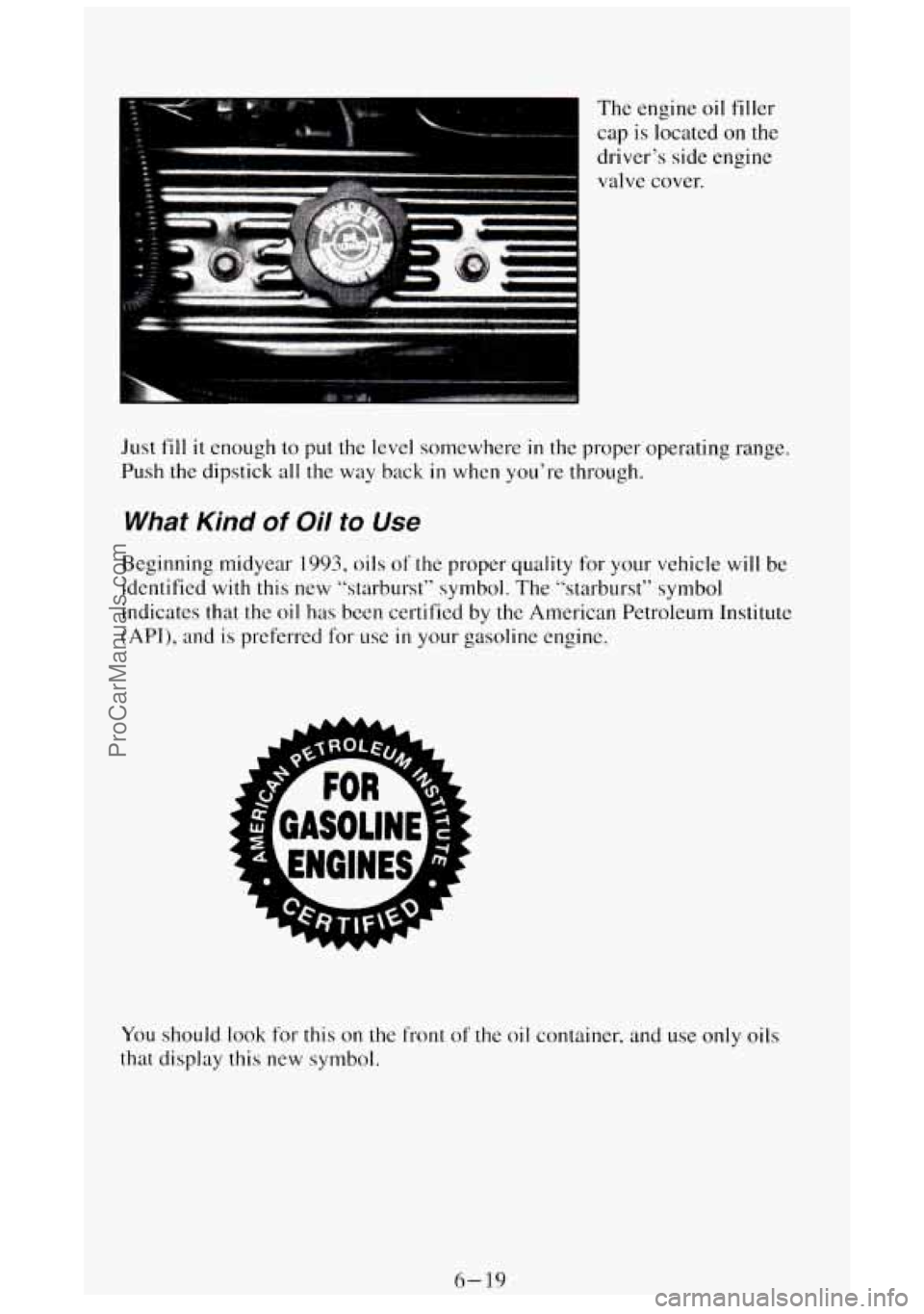
The engine oil filler
cap is located on
the
driver’s side engine
valve cover.
Just
fill it enough to put the level somewhere in the proper operating range.
Push the dipstick all the way back
in when you’re through.
What Kind of Oil to Use
Beginning midyear 1993, oils of the proper quality for your vehicle will be
identified with this new “starburst” symbol. The “starburst” symbol
indicates that
the oil has been certified by the American Petroleum Institute
(API), and
is preferred for use in your gasoline engine.
YOU should look for this on the front of the oil container, and use only oils
that display this new symbol.
6- 19
ProCarManuals.com
Page 270 of 404
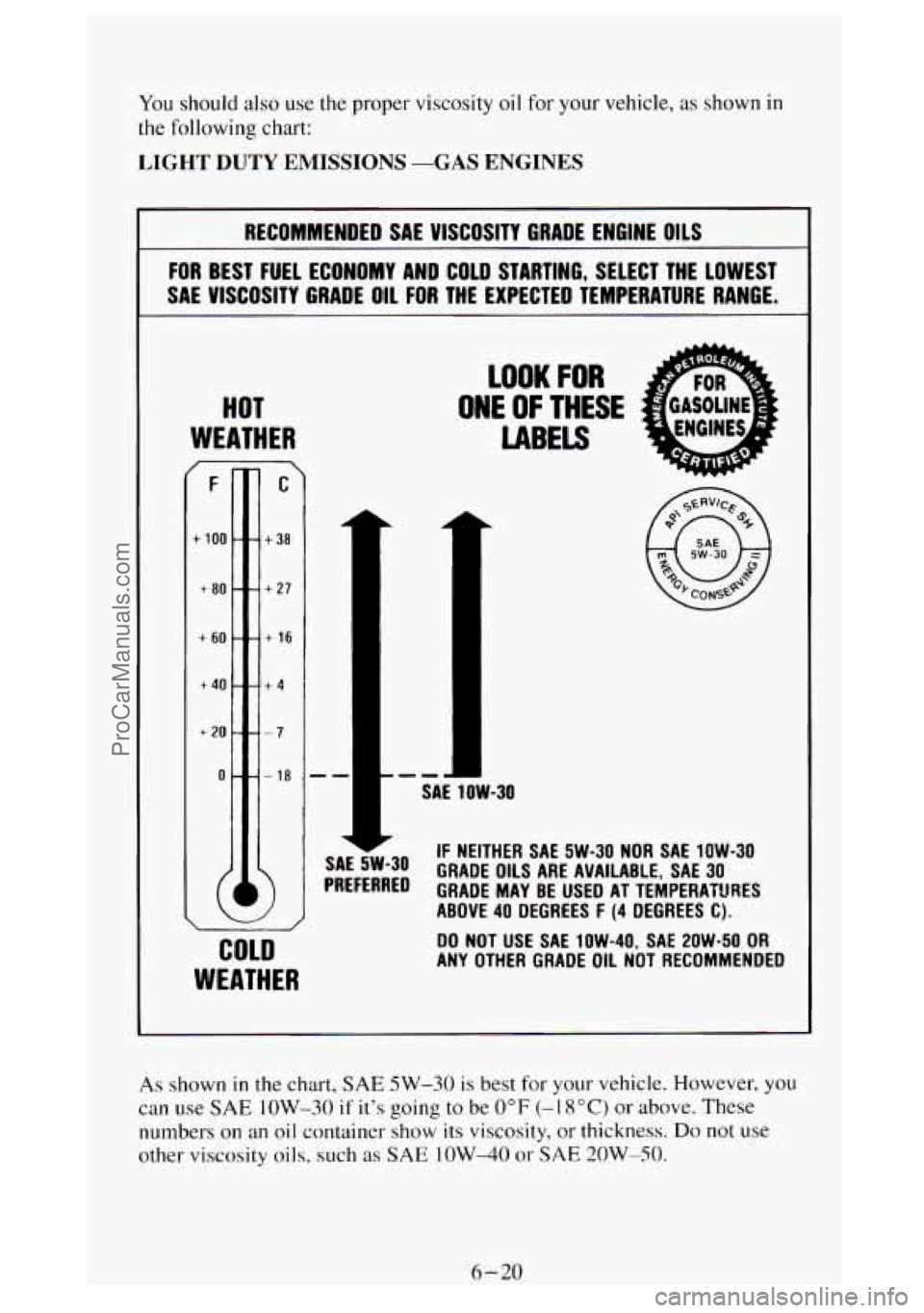
You should also use the proper viscosity oil for your vehicle, as shown in
the following chart:
LIGHT DUTY EMISSIONS -GAS ENGINES
RECOMMENDED SAE VISCOSITY GRADE ENGINE OILS
FOR BEST FUEL ECONOMY AND COLD STARTING, SELECT THE LOWEST
SAE VISCOSITY GRADE OIL
FOR THE EXPECTED TEMPERATURE RANGE.
HOT
WEATHER
F
tlOO -
+80 -
+60 -
+40 -
+20 -
0-
C
t 38
t 27
t 16
t4
-7
- 18
m LOOK
ONE OF THESE
LABELS
-- -1 -I SAE 1OW-30
IF NEITHER SAE 5W-30 NOR SAE 1OW-30
5w-30 GRADE OILS ARE AVAILABLE, SAE 30
PREFERRED GRADE MAY BE USED AT TEMPERATURES
ABOVE
40 DEGREES F (4 DEGREES C).
DO NOT USE SAE 1OW-40, SAE 2OW-50 OR
ANY OTHER GRADE OIL NOT RECOMMENDED
As shown in the chart, SAE SW-30 is best for your vehicle. However, you
can use SAE 1OW-30 if it’s going to be 0°F (-1 8°C) or above. These
numbers on an
oil container show its viscosity, or thickness. Do not use
other viscosity oils, such as SAE lOW-40 or SAE 20W-50.
6-20
ProCarManuals.com